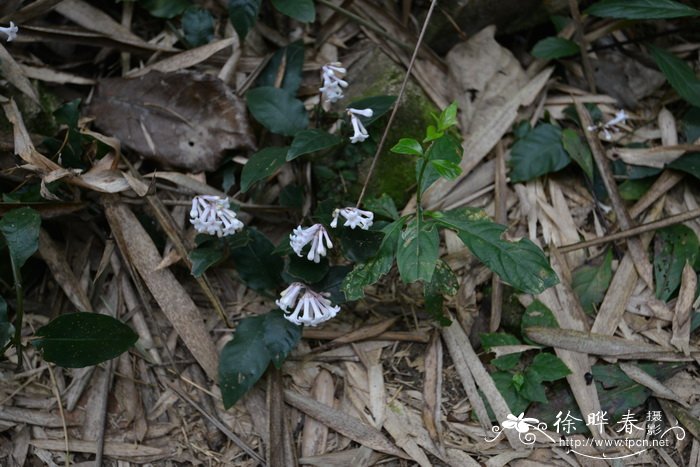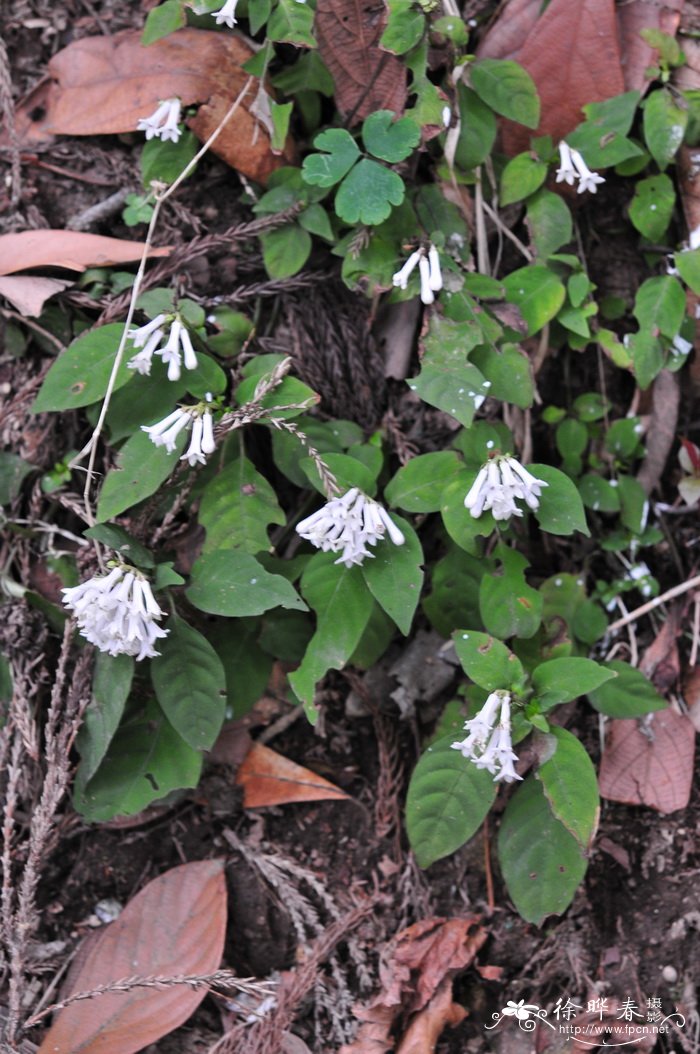日本蛇根草Ophiorrhiza japonica
中文名(Chinese Name):日本蛇根草
学名(Scientific Name):Ophiorrhiza japonica Bl.
英文名(English Common Name):
别名(Chinese Common Name):蛇根草
异名(Synonym):Ophiorrhiza cavaleriei H. Lév. Ophiorrhiza eryei Champion Ophiorrhiza acutiloba Hayata Ophiorrhiza monticola f. longistigma Hayata Ophiorrhiza monticola Hayata Ophiorrhiza monticola f. brevistigma Hayata Ophiorrhiza labordei H. Lév. Ophiorrhiza japonica var. acutiloba (Hayata) Ohwi Ophiorrhiza japonica var. minor Krause Ophiorrhiza dimorphantha f. brevistigma Hayata Ophiorrhiza dimorphantha f. longistigma Hayata Ophiorrhiza dimorphantha Hayata Ophiorrhiza eyrei Champ. ex Benth. Ophiorrhiza tashiroi Maxim. Ophiorrhiza japonica var. tashiroi (Maxim.) Ohwi Ophiorrhiza japonica f. plena T.Yamaz. Spigelia japonica Siebold ex Miq.
科属(Family & Genus):茜草科(Rubiaceae)蛇根草属
形态特征(Description):草本,高20-40厘米或过之;茎下部匐地生根,上部直立,近圆柱状,上部干时稍压扁,有二列柔毛。叶片纸质,卵形,椭圆状卵形或披针形,有时狭披针形,长通常4-8厘米,有时可达10厘米或稍过之,宽1-3厘米,顶端渐尖或短渐尖,基部楔形或近圆钝,干时上面淡绿色,下面变红色,有时两面变红色,亦有两面变绿黄色,通常两面光滑无毛,有时上面散生短糙毛,下面中脉和侧脉上被柔毛;中脉在上面近平坦,下面压扁,侧脉每边6-8条,纤细,弧状上升,末端近叶缘分枝消失,上面不很明显,下面微凸起;叶柄压扁,长通常1-2厘米,有时可达3厘米或过之,无毛或被柔毛;托叶脱落,未见。花序顶生,有花多朵,总梗长通常1-2厘米,多少被柔毛,分枝通常短,螺状;花二型,花柱异长;长柱花:花梗长1-2毫米,常被短柔毛;小苞片披针状线形或线形,长4-6毫米,渐尖,近无毛或被稀疏缘毛;萼近无毛或被短柔毛,萼管近陀螺状,长约1.3毫米,宽约1.4毫米,有5棱,裂片三角形或近披针形,长0.7-1.2毫米;花冠白色或粉红色,近漏斗形,外面无毛,管长1-1.3厘米,喉部扩大,里面被短柔毛,裂片5,三角状卵形,长2.5-3毫米,顶端内弯,喙状,里面被鳞片状毛,背面有翅,翅的顶部向上延伸成新月形;雄蕊5,着生在冠管中部之下,花丝无毛,长2-2.5毫米,花药线形,长2.5-3毫米;花柱长9-11毫米,被疏柔毛,柱头2裂,裂片近圆形或阔卵形,长约1毫米,不伸出;短柱花:花萼和花冠同长柱花;雄蕊生喉部下方,花丝长2-2.5毫米,花药长2.5毫米,不伸出;花柱长约3毫米,柱头裂片披针形,长约3毫米。蒴果近僧帽状,长3-4毫米,宽7-9毫米,近无毛。花期冬春,果期春夏。
分布(Distribution):产陕西、四川、湖北、湖南、安徽、江西、浙江、福建、台湾、贵州、云南、广西和广东,生于常绿阔叶林下的沟谷沃土上。日本、越南也有。
用途(Use):
引自中国植物志英文版:FOC Vol. 19 Page 259, 263, 264, 271, 272
Ophiorrhiza japonica Blume, Bijdr. 978. 1826.
日本蛇根草 ri ben she gen cao| Rubiaceae | Ophiorrhiza
Ophiorrhiza acutiloba Hayata; O. cavaleriei H. Léveillé; O. eryei Champion; O. dimorphantha Hayata; O. dimorphantha f. brevistigma Hayata; O. dimorphantha f. longistigma Hayata; O. japonica var. acutiloba (Hayata) Ohwi; O. japonica var. minor J. Krause; O. labordei H. Léveillé; O. monticola Hayata; O. monticola f. brevistigma Hayata; O. monticola f. longistigma Hayata; O. nigricans H. S. Lo.
Herbs, weak to ascending, to 60 cm tall, often drying flushed with purple or darkened; stems subterete to slightly compressed, glabrous or with 2 hirtellous or pilosulous lines. Leaves in subequal pairs; petiole 0.3-2(-3) cm, glabrous to hirtellous or puberulent; blade drying papery, ovate, elliptic-ovate, elliptic, elliptic-oblong, lanceolate, or narrowly lanceolate, 1-11 × 0.7-3.5 cm, glabrous to strigillose or hispidulous adaxially, glabrous to puberulent, hirtellous, or villosulous abaxially, base cuneate to obtuse, margins flat to crisped, apex acute to acuminate or rarely obtuse (to rounded, Ophiorrhiza nigricans); secondary veins 4-8 pairs; stipules triangular, 0.8-2 mm, glabrescent, acute to bifid, caducous sometimes leaving 1 to several thickened scars to 0.3 mm. Inflorescence congested-cymose to cymose, few to many flowered, puberulent to strigillose, pilosulous, or hirtellous; peduncle 0.5-5 cm (to 6 cm, O. nigricans); axes congested-cymose becoming helicoid; bracts lanceolate-linear, spatulate, or linear, 1-6 mm, sometimes glabrescent, persistent. Flowers distylous, on pedicels 1-2 mm. Calyx glabrous to densely puberulent or pilosulous; hypanthium subturbinate to oblate or subglobose, 0.8-1 mm, 5-ribbed; lobes triangular, 0.4-1.2 mm. Corolla white or pink, funnelform to tubular-funnelform, outside glabrous to puberulent or pilosulous and longitudinally winged, inside pilose near middle and pilosulous above middle through throat and sometimes onto lobes; tube 9-14 mm; lobes triangular to ovate, (1.5-1.8 mm, O. nigricans) 2.5-4 mm, dorsally with wing to 0.5 mm wide, apex rostrate. Capsules submitriform, 2.5-4 × 6.5-9 mm, pilosulous to glabrous. Fl. winter, fr. spring and summer.
Fertile soil of ravines in forests; 100-2400 m. Anhui, Fujian, Guangdong, Guangxi, Guizhou, Hainan, Hubei, Hunan, Jiangxi, S Shanxi?, Sichuan, Taiwan, NE Yunnan, Zhejiang [Japan, Vietnam].
Duan and Lin (Acta Phytotax. Sin. 45: 873. 2007) synonymized Ophiorrhiza nigricans with O. japonica. They also synonymized O. kwangsiensis with O. japonica, but that species is provisionally separated here based on the characters given in the key to species pending further study. The reproductive biology of O. japonica was studied by Nakamura et al. (J. Plant Res. 120: 501-509. 2007), who found the Chinese plants sampled to be distylous and diploid. The corollas are apparently similar between the two floral forms, with the reciprocally placed anthers and stigmas positioned near the middle of the corolla tube vs. at or just above its throat, respectively.


(责任编辑:徐晔春)
学名(Scientific Name):Ophiorrhiza japonica Bl.
英文名(English Common Name):
别名(Chinese Common Name):蛇根草
异名(Synonym):Ophiorrhiza cavaleriei H. Lév. Ophiorrhiza eryei Champion Ophiorrhiza acutiloba Hayata Ophiorrhiza monticola f. longistigma Hayata Ophiorrhiza monticola Hayata Ophiorrhiza monticola f. brevistigma Hayata Ophiorrhiza labordei H. Lév. Ophiorrhiza japonica var. acutiloba (Hayata) Ohwi Ophiorrhiza japonica var. minor Krause Ophiorrhiza dimorphantha f. brevistigma Hayata Ophiorrhiza dimorphantha f. longistigma Hayata Ophiorrhiza dimorphantha Hayata Ophiorrhiza eyrei Champ. ex Benth. Ophiorrhiza tashiroi Maxim. Ophiorrhiza japonica var. tashiroi (Maxim.) Ohwi Ophiorrhiza japonica f. plena T.Yamaz. Spigelia japonica Siebold ex Miq.
科属(Family & Genus):茜草科(Rubiaceae)蛇根草属
形态特征(Description):草本,高20-40厘米或过之;茎下部匐地生根,上部直立,近圆柱状,上部干时稍压扁,有二列柔毛。叶片纸质,卵形,椭圆状卵形或披针形,有时狭披针形,长通常4-8厘米,有时可达10厘米或稍过之,宽1-3厘米,顶端渐尖或短渐尖,基部楔形或近圆钝,干时上面淡绿色,下面变红色,有时两面变红色,亦有两面变绿黄色,通常两面光滑无毛,有时上面散生短糙毛,下面中脉和侧脉上被柔毛;中脉在上面近平坦,下面压扁,侧脉每边6-8条,纤细,弧状上升,末端近叶缘分枝消失,上面不很明显,下面微凸起;叶柄压扁,长通常1-2厘米,有时可达3厘米或过之,无毛或被柔毛;托叶脱落,未见。花序顶生,有花多朵,总梗长通常1-2厘米,多少被柔毛,分枝通常短,螺状;花二型,花柱异长;长柱花:花梗长1-2毫米,常被短柔毛;小苞片披针状线形或线形,长4-6毫米,渐尖,近无毛或被稀疏缘毛;萼近无毛或被短柔毛,萼管近陀螺状,长约1.3毫米,宽约1.4毫米,有5棱,裂片三角形或近披针形,长0.7-1.2毫米;花冠白色或粉红色,近漏斗形,外面无毛,管长1-1.3厘米,喉部扩大,里面被短柔毛,裂片5,三角状卵形,长2.5-3毫米,顶端内弯,喙状,里面被鳞片状毛,背面有翅,翅的顶部向上延伸成新月形;雄蕊5,着生在冠管中部之下,花丝无毛,长2-2.5毫米,花药线形,长2.5-3毫米;花柱长9-11毫米,被疏柔毛,柱头2裂,裂片近圆形或阔卵形,长约1毫米,不伸出;短柱花:花萼和花冠同长柱花;雄蕊生喉部下方,花丝长2-2.5毫米,花药长2.5毫米,不伸出;花柱长约3毫米,柱头裂片披针形,长约3毫米。蒴果近僧帽状,长3-4毫米,宽7-9毫米,近无毛。花期冬春,果期春夏。
分布(Distribution):产陕西、四川、湖北、湖南、安徽、江西、浙江、福建、台湾、贵州、云南、广西和广东,生于常绿阔叶林下的沟谷沃土上。日本、越南也有。
用途(Use):
引自中国植物志英文版:FOC Vol. 19 Page 259, 263, 264, 271, 272
Ophiorrhiza japonica Blume, Bijdr. 978. 1826.
日本蛇根草 ri ben she gen cao| Rubiaceae | Ophiorrhiza
Ophiorrhiza acutiloba Hayata; O. cavaleriei H. Léveillé; O. eryei Champion; O. dimorphantha Hayata; O. dimorphantha f. brevistigma Hayata; O. dimorphantha f. longistigma Hayata; O. japonica var. acutiloba (Hayata) Ohwi; O. japonica var. minor J. Krause; O. labordei H. Léveillé; O. monticola Hayata; O. monticola f. brevistigma Hayata; O. monticola f. longistigma Hayata; O. nigricans H. S. Lo.
Herbs, weak to ascending, to 60 cm tall, often drying flushed with purple or darkened; stems subterete to slightly compressed, glabrous or with 2 hirtellous or pilosulous lines. Leaves in subequal pairs; petiole 0.3-2(-3) cm, glabrous to hirtellous or puberulent; blade drying papery, ovate, elliptic-ovate, elliptic, elliptic-oblong, lanceolate, or narrowly lanceolate, 1-11 × 0.7-3.5 cm, glabrous to strigillose or hispidulous adaxially, glabrous to puberulent, hirtellous, or villosulous abaxially, base cuneate to obtuse, margins flat to crisped, apex acute to acuminate or rarely obtuse (to rounded, Ophiorrhiza nigricans); secondary veins 4-8 pairs; stipules triangular, 0.8-2 mm, glabrescent, acute to bifid, caducous sometimes leaving 1 to several thickened scars to 0.3 mm. Inflorescence congested-cymose to cymose, few to many flowered, puberulent to strigillose, pilosulous, or hirtellous; peduncle 0.5-5 cm (to 6 cm, O. nigricans); axes congested-cymose becoming helicoid; bracts lanceolate-linear, spatulate, or linear, 1-6 mm, sometimes glabrescent, persistent. Flowers distylous, on pedicels 1-2 mm. Calyx glabrous to densely puberulent or pilosulous; hypanthium subturbinate to oblate or subglobose, 0.8-1 mm, 5-ribbed; lobes triangular, 0.4-1.2 mm. Corolla white or pink, funnelform to tubular-funnelform, outside glabrous to puberulent or pilosulous and longitudinally winged, inside pilose near middle and pilosulous above middle through throat and sometimes onto lobes; tube 9-14 mm; lobes triangular to ovate, (1.5-1.8 mm, O. nigricans) 2.5-4 mm, dorsally with wing to 0.5 mm wide, apex rostrate. Capsules submitriform, 2.5-4 × 6.5-9 mm, pilosulous to glabrous. Fl. winter, fr. spring and summer.
Fertile soil of ravines in forests; 100-2400 m. Anhui, Fujian, Guangdong, Guangxi, Guizhou, Hainan, Hubei, Hunan, Jiangxi, S Shanxi?, Sichuan, Taiwan, NE Yunnan, Zhejiang [Japan, Vietnam].
Duan and Lin (Acta Phytotax. Sin. 45: 873. 2007) synonymized Ophiorrhiza nigricans with O. japonica. They also synonymized O. kwangsiensis with O. japonica, but that species is provisionally separated here based on the characters given in the key to species pending further study. The reproductive biology of O. japonica was studied by Nakamura et al. (J. Plant Res. 120: 501-509. 2007), who found the Chinese plants sampled to be distylous and diploid. The corollas are apparently similar between the two floral forms, with the reciprocally placed anthers and stigmas positioned near the middle of the corolla tube vs. at or just above its throat, respectively.
(责任编辑:徐晔春)
踩一下[0]

顶一下[1]